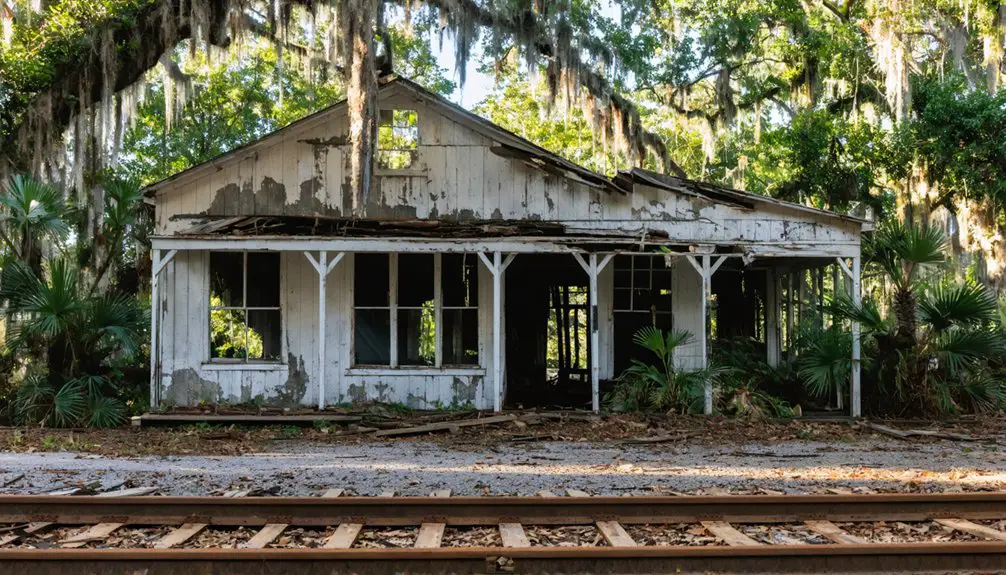You’ll find Pine Level’s remains in Florida’s DeSoto County, where this once-thriving frontier town emerged in the 1850s. As a Republican stronghold during Reconstruction, it served as the county seat until 1888, boasting fourteen saloons, a bustling courthouse square, and railway connections. Despite its peak as a timber and cattle hub, Pine Level declined after losing its political status and railway access. The weathered churches and cemetery markers hold stories of vigilante justice and frontier dreams.
Key Takeaways
- Pine Level, Florida evolved from a bustling frontier town with fourteen saloons into a ghost town following economic decline in the 1930s.
- The town lost its county seat status to Arcadia in 1888, triggering a downward spiral in political influence and commerce.
- When Florida Southern Railroad bypassed Pine Level, businesses closed and transportation costs increased, leading to community abandonment.
- Today, only two original churches, cemeteries, and remnants of the courthouse chimney stand as witnesses to Pine Level’s existence.
- The ghost town earned National Register of Historic Places status in 2014, preserving its historical significance in Florida’s frontier era.
The Birth of a Frontier Settlement
As settlers pushed into Florida’s frontier lands during the 1850s, Pine Level emerged as a small but determined community in what would later become DeSoto County. You’d have found these early pioneers establishing themselves in virtual wilderness, facing frontier challenges that tested their resolve daily.
They built basic homes, stores, and churches, gradually transforming the untamed landscape into a livable settlement. The community’s reputation for rowdiness grew as fourteen saloons operated in the small town. Their agricultural practices sustained the growing population, while trade networks eventually stretched far beyond their isolated location. To avoid confusion with other places named Pine Level, historical records from this era specifically indicate this settlement as Pine Level, Florida.
Rise to Political Power
While the birth of Pine Level appeared organic on the surface, its true origins stemmed from calculated political maneuvering during Reconstruction. You’ll find that Republican influence transformed this frontier outpost into a strategic county seat, deliberately replacing Confederate-sympathizing Manatee in 1866.
Pine Level’s establishment was no accident, but rather a calculated Republican move to seize power from Confederate sympathizers during Reconstruction.
As a political strategy, Pine Level’s establishment served dual purposes: it provided geographic centrality while punishing Southern resistance.
You’d have witnessed the town’s early development focused almost entirely on government buildings – a courthouse, jail, and post office – rather than natural community growth. Under Captain John H. Bartholf’s leadership as postmaster, Pine Level became a Republican stronghold in hostile territory, though this power didn’t come without violent opposition. The town experienced sluggish initial growth as local residents resisted the Republican-imposed changes. The area’s lawlessness was evident as fourteen saloons operated in the small town.
In 1876, armed Democrats forced Bartholf at gunpoint to release disputed presidential election ballots, highlighting the intense political struggles of the era.
Daily Life in Old Pine Level

Despite its politically charged origins, Pine Level evolved into a bustling frontier town where daily life centered around the courthouse square.
You’d find yourself among a mix of commerce and community events, from browsing dry goods stores to attending services at Mount Pleasant Baptist or Pine Level Methodist churches. Social gatherings often took place at local saloons, though these venues frequently erupted in gunfights, reflecting the town’s untamed spirit.
The railroad depot buzzed with activity as timber and cattle moved through the East and West Coast Railway, while warehouses and sawmills provided steady employment.
You might catch up on local news at the newspaper office or witness prisoners attempting daring escapes from the particularly flimsy jail. The schoolhouse and churches offered respite from the often-lawless atmosphere.
Law, Order, and the Vigilantes
Behind Pine Level’s courthouse facade lay a dark underbelly of vigilante justice and lawlessness that would ultimately contribute to the town’s downfall. In 1884, you’d have found the Sarasota Vigilance Committee secretly operating from Pine Level, a group of 22 members who’d later earn the chilling nickname “Sarasota Assassination Society” from the New York Times.
While masquerading as a political fraternity, they released a reign of terror through murders, bank robberies, and intimidation.
Even when Sheriff Watson captured 20 vigilantes in 1885, Pine Level’s crumbling jail and incomplete courthouse couldn’t contain them.
Escapees slipped through roof holes, leaving taunting notes, while those convicted served merely three years. This lawlessness impacted every aspect of daily life, as gunfights, gambling, and violence became the norm on Pine Level’s streets.
Economic Peaks and Railway Days
You’d find Pine Level’s economic golden age centered around its bustling railway hub, where the East and West Coast Railway connected the town to major markets in 1915.
The railway’s presence spurred rapid growth in Pine Level’s lumber industry, with the local sawmill shipping timber products along the 50-mile line to Bradenton and beyond. Regular shipments of mail and grain moved through the station as part of the railway’s vital commodity transport operations.
Your cattle would’ve joined the steady stream of commerce flowing through Pine Level’s 1,348-foot railway siding, marking the town’s peak as an essential trading post before its eventual decline in the 1930s.
Railway Hub Operations
Pine Level’s rise as a railway hub began on May 3, 1915, when the East and West Coast Railway established its 50-mile route connecting Bradenton to Arcadia.
You’d find the town strategically positioned 41 miles from Bradenton, where railway logistics centered around a well-equipped depot, 1,348-foot siding, and 524-foot spur track.
The hub’s freight connections proved essential for the region’s economic growth, linking coastal markets to inland resources.
You could’ve witnessed trains loading lumber from the local sawmill, while multiple logging roads branched from the mainline.
The station’s infrastructure handled mail services and phosphate shipments, making Pine Level a key transportation node.
Lumber Industry Growth
As northwest Florida’s timber industry flourished in the 1830s, Pine Level emerged as a considerable lumber production center by the turn of the century.
You’d have witnessed the transformation from small family-owned operations producing just hundreds of thousands of board feet to massive steam-powered enterprises churning out millions.
The introduction of advanced sawmill technology revolutionized the industry’s capabilities. Where water-powered mills once employed just 6-8 laborers, steam engines and circular saws dramatically increased output. Car houses provided basic housing accommodations for the growing workforce.
By 1819, the area saw its first major technological advancement when a water-powered sawmill was constructed near Jacksonville.
You could’ve seen entire communities spring up around these operations, complete with worker housing, stores, and schools.
By 1909, Florida’s lumber production peaked at 1.25 billion board feet, with Pine Level’s mills contributing considerably to this boom.
The naval stores industry thrived alongside lumber production, making Florida a global leader in pine resin products.
Cattle Trade Peak
While lumber brought initial prosperity to the region, cattle ranching emerged as an essential economic force in the 1870s that would transform Pine Level into a significant trading hub.
Cracker cowmen braved harsh Florida terrain to drive their herds through the region. You’d find cattlemen marking their herds through cattle branding and ear notching, essential practices for herd management on the open range. The trade flourished as ranchers sold their stock to Cuban markets, using their profits to acquire more land and improve their herds.
Pine Level’s peak as a cattle center wouldn’t last long, though. When Arcadia gained railroad access and became the county seat in 1888, you could see the shift happening. With thousands of range cattle grazing on local prairies, DeSoto County emerged as a leading cattle producer in the South.
The cattle trade gradually moved toward Arcadia’s superior transport links, marking the beginning of Pine Level’s decline.
The Path to Abandonment

You’d have witnessed Pine Level’s dramatic fall from prominence when the Florida Southern Railroad chose to bypass the town in favor of Arcadia, setting off a chain of economic misfortunes.
The town’s political influence crumbled further as it lost its county seat status to Arcadia in 1888, marking the end of its brief reign as DeSoto County’s administrative center.
Railroad Bypass Impact
The Florida Southern Railroad’s fateful decision to bypass Pine Level in favor of Arcadia marked the beginning of the town’s steady decline into abandonment.
The railroad significance of Pine Level diminished despite its East and West Coast Railway connection, as trade diversion to Arcadia reshaped regional commerce. Today, many historical records of Pine Level are preserved through digital collections management to ensure this ghost town’s story endures.
You’d have witnessed Pine Level’s transformation from a bustling hub to a struggling outpost.
- The town’s once-thriving sawmill operations withered as transportation costs soared.
- Local businesses shuttered their doors as customer traffic dwindled.
- Pine Level’s isolation deepened when the ICC authorized track abandonment in 1933.
Political Power Shifts
Since its founding during Reconstruction, Pine Level stood as a Republican stronghold in Confederate-sympathizing Florida, where political power struggles would ultimately seal the town’s fate.
You’ll find the town’s political rivalry reached its boiling point during the 1876 Tilden-Hayes election, when postmaster John H. Bartholf’s attempt to block ballot releases led to him being held at gunpoint by Democratic operatives.
The shifting power dynamics became clear as Pine Level’s brief tenure as DeSoto County’s seat lasted only 18 months before moving to Arcadia in 1889.
This transfer wasn’t just administrative – it represented the complete collapse of Republican influence in the region. As Democratic control solidified, Pine Level’s political importance vanished, taking with it the town’s prosperity and many of its residents.
Economic Activity Fades
As rail lines initially bypassed Pine Level during the 1880s railroad boom, the town’s economic prospects began to dim.
When the East and West Coast Railway finally arrived in 1913, it brought a brief surge of prosperity through lumber shipments, but this lifeline wouldn’t last.
By 1933, the devastating economic shifts that would seal Pine Level’s fate were in full swing.
- The sawmill, once the beating heart of local industry, struggled as timber resources dwindled.
- The railroad’s abandonment in 1934 cut off essential trade routes, isolating the community.
- Local businesses shuttered their doors as residents sought opportunities in Arcadia and Bradenton.
This community decline triggered a domino effect: without jobs, families left; without families, businesses failed; without commerce, Pine Level’s vitality faded into memory.
Historic Legacy and Modern Remnants

Located in Florida’s heartland, Pine Level’s historic legacy endures through a handful of surviving structures and landmarks that tell the story of its turbulent past.
You’ll find two original churches still standing sentinel over the ghost town‘s memories, while the Indian Mound and Pine Level Campground cemeteries preserve the final resting places of early settlers.
The toppled hanging tree and courthouse chimney remnants serve as stark reminders of the town’s notorious justice system and the violent era of the Sarasota Vigilance Committee.
Dark shadows of frontier justice linger in Pine Level’s fallen hanging tree, echoing the brutal legacy of vigilante law.
Thanks to historic preservation efforts and community engagement, the site earned National Register of Historic Places status in 2014.
Today, historical societies and social media keep Pine Level’s fascinating history alive, allowing you to explore this monument to Florida’s wild frontier days.
Frequently Asked Questions
What Was the Total Population of Pine Level at Its Peak?
While exact Pine Level population trends aren’t documented, historical demographics suggest you’d have found several hundred residents at its peak during the late 1800s when it served as a county seat.
Are There Any Known Photographs of Pine Level From Its Heyday?
You won’t find widely published photographs from Pine Level’s heyday, despite its historical significance. While local archives may hold some photographic evidence, most available images show only modern ruins and remaining structures.
What Happened to the Original Residents When the Town Declined?
You’ll find that most folks relocated to Arcadia for jobs, while some stayed behind to farm. Relocation patterns show families gradually scattered, though community memories lived on through churches and cemeteries.
Were There Any Notable Natural Disasters That Affected Pine Level?
While Mother Nature’s wrath occasionally visited the area, you’ll find limited records of disasters. The only documented natural event was a hurricane that toppled the historic Hanging Tree.
Did Any Famous Historical Figures Ever Visit or Stay in Pine Level?
You won’t find records of famous historical visits or notable guests in Pine Level, though local judges and journalists passed through during its time as county seat from 1866-1888.
References
- https://www.fortogden.com/ghost-town-pine-level-fl/
- https://en.wikipedia.org/wiki/Pine_Level
- http://peacerivervalley.blogspot.com/2011/02/ghost-town-of-pine-level-florida.html
- https://www.pinelevelchurch.com/history
- https://visitdesoto.com/location/site-of-old-pine-level/
- https://digitalcommons.usf.edu/etd/3745/
- https://www.itsfloridacountry.com/exploring-floridas-best-ghost-towns-and-abandoned-places/
- https://floridahistoryblog.com/desoto-county-seat-moves-from-pine-level-to-arcadia/
- https://thebradentontimes.com/stories/sunday-favorites-where-and-what-was-pine-level
- https://en.wikipedia.org/wiki/East_and_West_Coast_Railway



